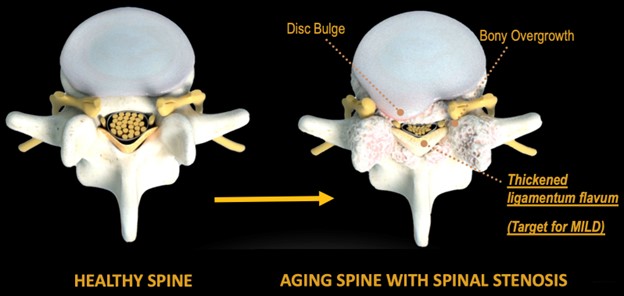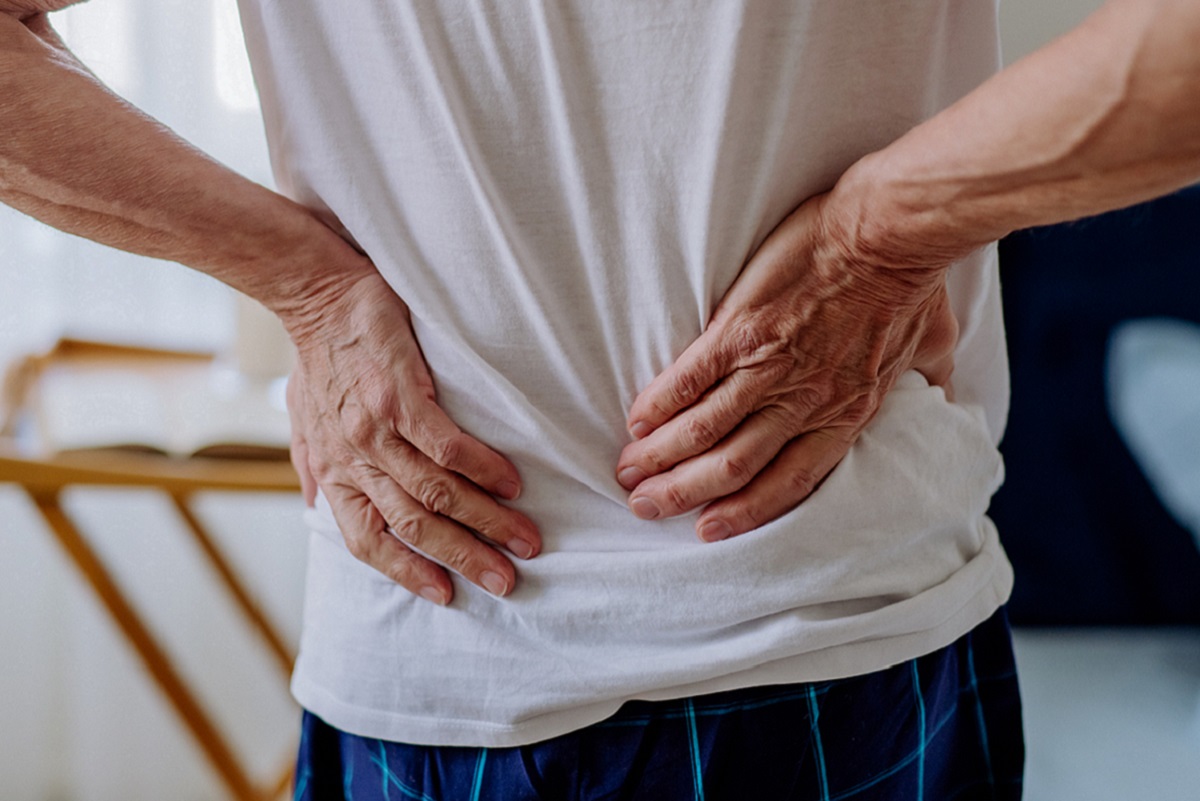Minimally invasive therapies such as the MILD procedure can help
Many of us experience a sore back now and then. We tend to brush it off as aches and pains caused by doing yard work, pushing too hard in the gym, or lifting heavy objects. However, your pain may be linked with a common condition that affects a growing number of people.
More than 2.4 million Americans are being actively treated for a condition called Lumbar spinal stenosis, or LSS. It is a common cause of low back and leg pain and the number of cases is estimated to increase to 18 million people over the next decade. 20% of people over age 60 have LSS.
Anatomic representation of the age-related changes of the spine that lead to lumbar spinal stenosis. The MILD procedure specifically targets the thickened ligament that compresses nerves and causes symptoms (pain) related to lumbar spinal stenosis. Courtesy Vertos Medical.
Stenosis is another word for the narrowing of the space around the spinal cord. It puts pressure on the nerves of the spine. There are often many causes of stenosis. They include bony overgrowths, bulging discs, and thickening ligaments.

How does this affect patients? Spinal stenosis that affects the central canal of the spine often leads to pain, burning, numbness, tingling, or a sensation of heaviness in the back, buttocks, thighs, and/or legs. These symptoms worsen when standing up straight and walking but are improved by sitting down or leaning forward.
Have you seen someone leaning forward on a shopping cart? This is often a sign of LSS, and bending over provides temporary relief. LSS can also disrupt sleep since symptoms are closely related to how the body is positioned. The pain is caused when the nerves are pinched as the spinal canal narrows.
We diagnose LSS based mostly on physical symptoms. We use imaging to confirm the condition’s presence. Historically, treatment options included pain medications, physical therapy, and steroid shots. When patients did not find relief from these options, the alternative was surgery. Luckily, today we use new outpatient treatment options that do not require surgery. This fills the therapeutic gap between injections and traditional surgery.
Minimally Invasive Lumbar Decompression, known as the MILD procedure, is a great option for patients with LSS. It is an outpatient, non-surgical, minimally invasive procedure requiring about 45 minutes to complete without general anesthesia.
Through one, quarter-inch incision guided by X-rays, the doctor removes bone fragments and thins out bulky ligaments. This gives more room for the nerves and relieves the symptoms of LSS. The patient faces minimal recovery and resumes normal activity within a couple of days. The recovery phase is more of a rehabilitative period where the focus is on increasing activity like walking.
Clinical studies find that about 85% of patients find meaningful relief and improved function after MILD. They usually see improvement in how long they can stand, how far they can walk, and experience less of the pain and burning associated with spinal stenosis. This relief lasts longer than steroid shots and usually does not need to be repeated.
While MILD may not provide relief for everyone, it is more effective than steroid shots. If necessary, a patient can still undergo traditional surgery. However, data shows that nearly 90% of people who undergo the MILD procedure avoid traditional surgery up to five years after the procedure.
If you or someone you know is suffering from pain and impaired function due to spinal stenosis, talk with your doctor to see if MILD is right for you.
Dr. Jason Williams, MD, is dual-board certified in both anesthesiology and interventional pain medicine. He practices at Saint Alphonsus Regional Medical Center in both Boise and Nampa. Dr. Williams is passionate about kyphoplasty as a tool to restore function and improve quality-of-life in his patients. He was also the first physician to perform the SpineJack procedure for vertebral compression fractures at Saint Alphonsus. To make an appointment, please call 208-367-2200.


